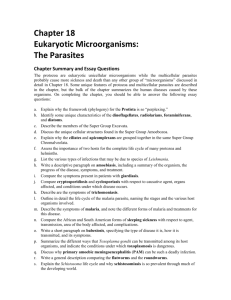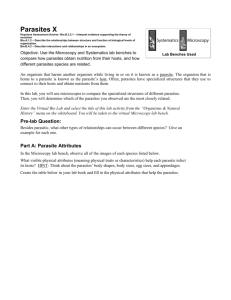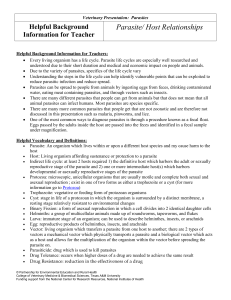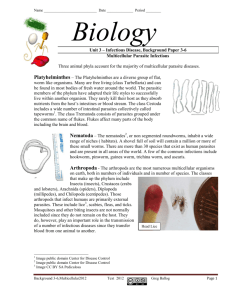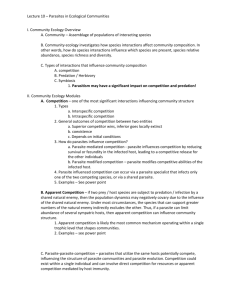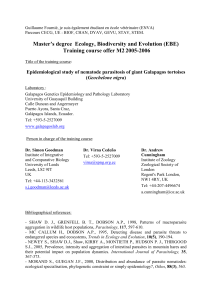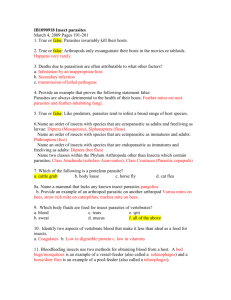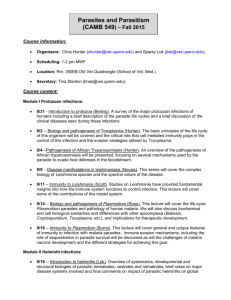Parasite
advertisement
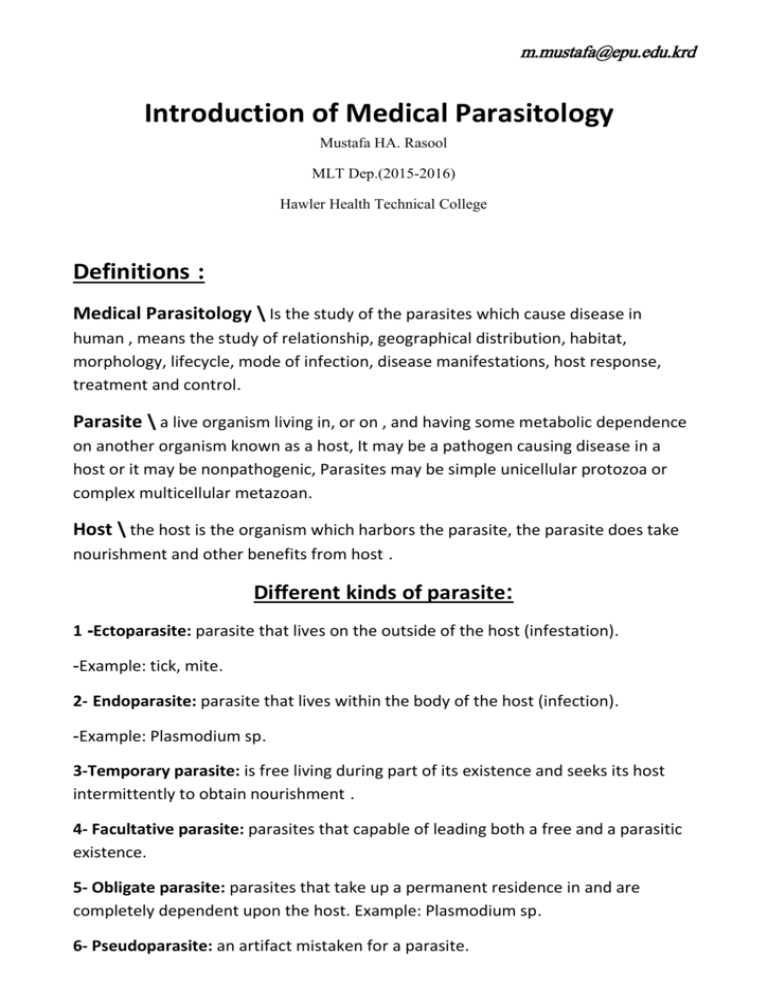
m.mustafa@epu.edu.krd Introduction of Medical Parasitology Mustafa HA. Rasool MLT Dep.(2015-2016) Hawler Health Technical College Definitions : Medical Parasitology \ Is the study of the parasites which cause disease in human , means the study of relationship, geographical distribution, habitat, morphology, lifecycle, mode of infection, disease manifestations, host response, treatment and control. Parasite \ a live organism living in, or on , and having some metabolic dependence on another organism known as a host, It may be a pathogen causing disease in a host or it may be nonpathogenic, Parasites may be simple unicellular protozoa or complex multicellular metazoan. Host \ the host is the organism which harbors the parasite, the parasite does take nourishment and other benefits from host . Different kinds of parasite: 1 -Ectoparasite: parasite that lives on the outside of the host (infestation). -Example: tick, mite. 2- Endoparasite: parasite that lives within the body of the host (infection). -Example: Plasmodium sp. 3-Temporary parasite: is free living during part of its existence and seeks its host intermittently to obtain nourishment . 4- Facultative parasite: parasites that capable of leading both a free and a parasitic existence. 5- Obligate parasite: parasites that take up a permanent residence in and are completely dependent upon the host. Example: Plasmodium sp. 6- Pseudoparasite: an artifact mistaken for a parasite. m.mustafa@epu.edu.krd 7- Coprozoic parasite: a foreign species that has passed through the alimentary tract without infecting the host. 8- Incidental parasite: parasite that establishes itself in a host which it does not ordinarily live . 9- Permanent parasite: remains on or in the body of the host from early life until maturity, sometimes for its entire life. 10- Pathogenic parasite: parasite that cause injury to the host by its mechanical, traumatic, or toxic activities. ***************************************************** Different kinds of hosts 1- Definitive host: The final host harbors the adult or sexual stage of the parasite. Example: human for the Schistosome sp. 2- Intermediate host: Host that part or all of the larval or asexual stage may take place in another animal. Example: snail for the schistosome. It can be, two intermediate hosts for a parasite life cycle: primary and secondary intermediate host. 3- Incidental host: The situation in which the infected individual is not necessary for the parasite’s survival or development. 4- Paratenic host : Harbors the parasite in an arrested state of development; However the parasite is capable of continuing its cycle in a subsequent suitable host. 5- Dead-end host : Human or incidental host is called as dead-end host if the cycle for transmission of the parasite is such as that it cannot be transmitted further. 6- Reservoir host: Animal that harbors the some parasite. These hosts ensure continuity of the parasite’s life cycle and act as additional sources of human infection. m.mustafa@epu.edu.krd THE NATURE OF HOST-PARASITE INTERACTIONS These interactions or associations may be as follows: 1- Symbiosis \ Is an association in which both are so dependent upon each other, that one cannot live without the help of other and none of the partners suffers any harm the association. 2- Commensalism \ is an association in which the parasite is gain benefits without causing injures to the host, one partner is benefited, the other is unaffected. 3- Mutualism \ is an association where both of the parasite and host are benefited; it is another form of symbiosis. 4- Parasitism \ Is an association where parasite gets benefit and the host gets nothing, in return always suffer some injury. -any reciprocal association in which a species depends upon another for its existence. ********************************************************************* Mechanism of disease production by parasites A. The effect of parasites on their host: The damage which pathogenic parasites produce in the tissue of the host may be affected in any of the following ways : 1- Mechanical injury \ produce of pressure as it grow larger. E.g\ hydated syst … by blockage of ducts such as blood vessels. 2- Deleterious action of toxic substances \ E.g\ producing of tissue dissolving enzymes by En.hystolytica which cause lesions in human gut. 3- Deprivation of nutrients, fluids and metabolites \ Parasites my produce disease by competing with the host for food. 4- Introduction of pathogenic microorganism's \ bacterial infection of lesions produced initially by parasites which sometimes become lethal. m.mustafa@epu.edu.krd B. The effect of the host on parasites \ May produce different types of host reaction on the parasites: 1- Immunological response. 2- The diet or nutritional status of the host. High-protein diet ~ intestinal protozoa Carbohydrate in the diet ~ tapeworms ********************************************************************* Geographic distribution 1- Tropical countries are most favorable places for the survival, larval development, and transmission of parasites. Optimal conditions of temperature and humidity are present. 2- Short summer season prevents the development of many species that required high temperatures during their larval stages. 3- Intense dry heat / direct sunlight may destroy the larval forms. 4- Low temperatures arrest the development of eggs and larvae and may even destroy them. 5- Moisture is essential for the development of free-living larvae and propagation of intermediate hosts, arthropods, snails and fishes . ********************************************************************* Life cycle The parasitic life cycle is the obligatory of parasites for their growth, development and multiplication that may be accomplished in their host (or hosts) or environment . 1- Directly –simple, only need a host. 2- Indirectly –complicated, need more than a host . The life cycle depends on the type of parasites. m.mustafa@epu.edu.krd classification The parasitic organisms that are importance for human health are eukaryotes - they have a well-defined chromosome in a nuclear membrane. Parasites are classified into 2 sub-kingdoms : A. Protozoa (unicellular(. B. Metazoan (multicellular.( Medically important parasites generally include: 1- Medical Protozoology. 2- Medical Helminthology. 3- Medical Entomology. Sub-kingdom \ Protozoa: 1- Class \ Sarcodina (Rhizopoda(. 2- Class \ Mastigophora (Flagellata(. 3- Class \ Sporozoa. 4- Class \ Cilliata Sub-kingdum \ Metazoa: 1- Class \ Trematoda. 2- Class \ Nematoda. 3- Class \ Cestoda. ********************************************************************
